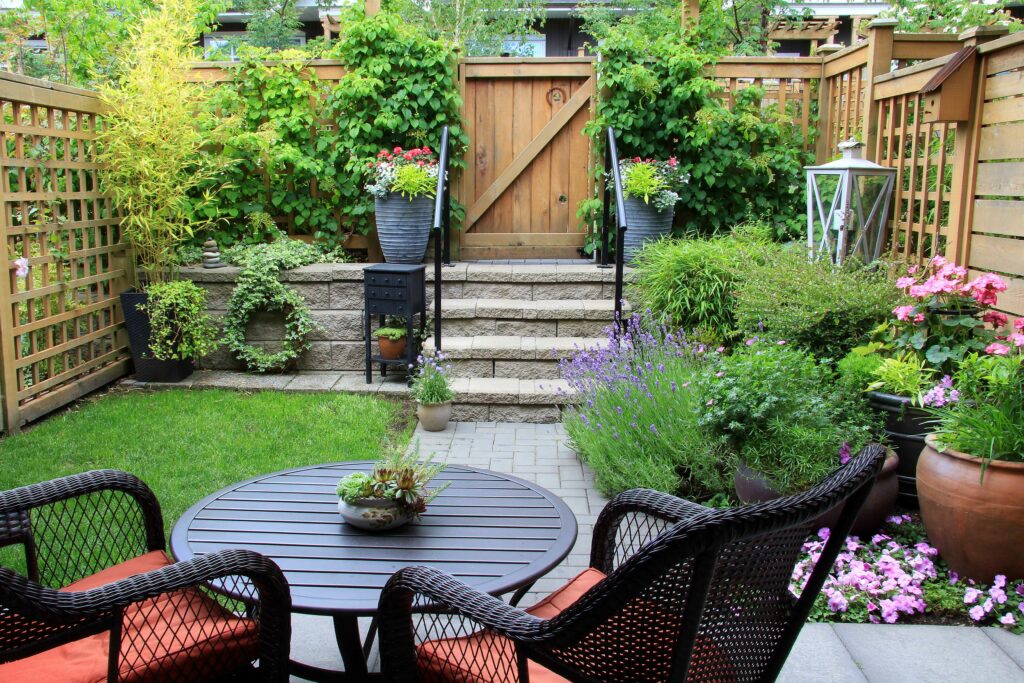In today’s increasingly urbanised world, having a garden can be a luxury. And if you’re lucky enough to have a small patch of green in your home, you might be wondering how to make the most of it. Fear not, fellow green-fingered enthusiast! With a little creativity, you can transform your modest garden into a thriving, functional space. In this article, we’ll explore some ingenious tips and advice to help you maximise your small garden and make it work for you.

Vertical Gardening
One of the most effective ways to utilise your limited space is to think vertically. Vertical gardens, also known as living walls or green walls, are a fantastic way to maximise your planting area without taking up valuable floor space. You can achieve this by installing wall-mounted planters, hanging baskets, or trellises. Climbing plants like ivy, clematis, and honeysuckle are perfect for a vertical garden, providing both visual appeal and fragrance.
Prune and Shape
Keeping large bushes and trees pruned and well-maintained is essential for creating a sense of spaciousness. Overgrown plants can make your garden feel cramped and dark. Regular pruning helps to maintain a tidy appearance, improve air circulation, and encourage healthy growth. Pruning also allows you to shape your plants, creating a more open and inviting environment.
Garden Mirrors
Garden mirrors are an excellent tool for creating an illusion of space in a small garden. By reflecting light and the surrounding greenery, mirrors can make your garden feel larger and brighter. Place mirrors strategically on walls or fences to achieve the best effect. Opt for weather-resistant materials like acrylic or stainless steel to ensure longevity.
Creative Paving
Incorporating creative paving into your garden design is a clever way to make a small space feel more expansive. Consider using different colours, shapes, and sizes of paving stones to create visual interest and guide the eye through the garden. Diagonal or curved paving patterns can also make the space appear larger. Additionally, permeable paving options help to manage rainfall and contribute to sustainable urban drainage systems.
Plant Ladders and Tiered Planters
Plant ladders and tiered planters are another effective solution for maximising planting space in a small garden. These structures allow you to grow plants at different heights, adding depth and visual interest. They are particularly useful for growing herbs, small vegetables, or flowers. Ensure you choose plants with similar light and water requirements to simplify maintenance.
Compact and Clever Furniture
Selecting the right furniture can make all the difference in a small garden. Opt for compact, foldable, or stackable furniture that can be easily stored away when not in use. This will allow you to maximise your space and maintain a clean, uncluttered environment. Multi-functional furniture, such as benches with built-in storage or tables that double as plant stands, can also help you get the most out of your limited space.
Container Gardening
Growing plants in containers is a versatile and space-saving way to add greenery to your small garden. Containers can be moved around easily, allowing you to change the layout and create different focal points. They also offer excellent drainage and can be tailored to suit your plants’ specific needs. Choose containers in various shapes, sizes, and materials to create an eclectic and visually appealing display.
Use Height and Levels
Incorporating different levels into your garden design can create the illusion of a larger space. Raised beds, platforms, or decking can help to define distinct areas and add depth to your small garden. Combining plants of varying heights also contributes to this effect, giving your garden a more dynamic and layered appearance. Tall, slender plants like grasses, bamboos, or columnar trees can draw the eye upwards, making the space feel more expansive.
Strategic Planting
Choosing the right plants and positioning them strategically can make a significant impact on the perceived size of your garden. Use plants with smaller leaves and delicate textures to create a sense of depth, as larger leaves can dominate the space. Plant taller plants in the back and shorter plants in the front to create a sense of perspective. You can also utilise colour to your advantage. Planting cooler hues like blues, purples, and greens in the background can create an illusion of distance, while warmer colours like reds, oranges, and yellows in the foreground can make the space feel more intimate.
Lighting
Thoughtful lighting can make your small garden feel more spacious and inviting, particularly during the evening hours. Use uplighting to highlight trees, shrubs, or architectural features, drawing the eye upwards and creating a sense of height. Pathway lights can guide visitors through the garden and create a sense of depth. Solar-powered or energy-efficient LED lights are an eco-friendly choice that won’t increase your energy bills!
With a bit of creativity and thoughtful planning, you can transform your small garden into a functional, beautiful space that feels larger than it actually is. By incorporating vertical gardening, strategic pruning, clever use of mirrors, creative paving, and more, you can create a garden that you’ll be proud to show off to friends and family. So, don your gardening gloves and get to work – your dream garden is just a few steps away!








